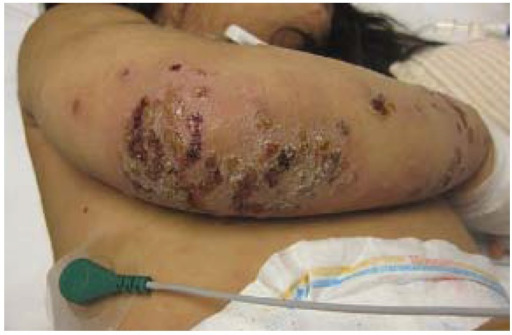Playlist
Show Playlist
Hide Playlist
Impetigo in Darker Skin: Epidemiology and Etiology
-
Slides Impetigo in Darker Skin Epidemiology Etiology.pdf
-
Download Lecture Overview
00:01 Welcome to our lecture series. 00:03 We are now going to focus on impetigo as one of the causes of bacterial skin infections. 00:11 It's a common, acute, highly contagious superficial bacterial skin infection. There are three variants of impetigo: nonbullous, bullous, ecthyma. 00:26 Most common bacterial infection in children is impetigo, and it accounts about 10% of skin problems observed in pediatric clinics. 00:35 It affects both genders equally, and it's more frequent in tropical climates and at lower altitudes. 00:43 Right. So if we talk about nonbullous impetigo, it is caused by Staphylococcus aureus. 00:49 And it is a main pathogen. 00:51 And this is how it looks like on electron micrograph. 00:56 The other etiological cause is beta hemolytic streptococci group A, but also C and G, can cause nonbullous impetigo. 01:05 This can happen alone or in combination with Staphylococcus aureus. 01:11 Looking at bullous impetigo, the strains of staph aureus that produce exfoliative toxin A cause bullous impetigo. 01:23 What are some of the risk factors in terms of getting the skin infections? Children between the ages of 2 to 6 years are usually affected, and this happens more commonly in crowded conditions, particularly in schools and in childcare settings. 01:40 It also happens in warm, humid weather, and it's more common in summer. Some of the risk factors include certain spots where one participates in sports that involve skin to skin contact, as you can see. 01:57 Broken skin can also be a risk factor, and the bacteria enters the skin through a small skin injury. 02:04 It could be an insect bite or rash. 02:07 As we mentioned that the skin barrier is one of the predisposing factors to skin infection a skin barrier that is impaired. 02:16 So let's have a look at the pathophysiology of impetigo. 02:20 So the bacteria are typically transferred to the skin through the direct contact with a contaminated object. 02:28 It's usually staph aureus and or beta-hemolytic strep group A. These bacteria transiently colonize the surface of the skin. 02:40 About 30% of the population is colonized by staph aureus in the anterior layers of your nose. 02:48 If there's a disruption of the skin, for example, due to scratching or trauma, or secondary to insect bites, which is a common condition, particularly in skin of color patients. 03:00 Then the bacteria can enter and cause an infection in the deeper layers of the skin, resulting in infection. 03:09 Nonbullous impetigo is the most common form of impetigo, and initially it presents with multiple papules on an erythematous base or red base. But of course, in dark skin you may not see the erythema. 03:23 It may be sort of more grayish and lichenoid. 03:26 These papules eventually evolve into pustules. 03:31 Pustules then rupture, leaving erosions with typically yellowish brown golden crusts. So this is a patient with nonbullous impetigo. 03:43 You can see the yellow crusting, the excoriations, and slight erythema and gray Issue around the lesions. 03:51 So talking about nonbullous Impetigo , the most common sites that are affected are usually around the nose and mouth. 04:00 This is especially because staph aureus is commonly found in anterior nests. It can spread to other areas by fingers, clothing, and towels. Bullous impetigo is less common than nonbullous impetigo, and this is the second type of impetigo. 04:24 Initially, vesicles are seen on an erythematous base if it's a light-skinned patient, otherwise it could be a grayish or brownish base. 04:33 The vesicles merge, forming flaccid bullae filled with fluid. 04:39 The bullae may rupture to form erosions , with thin brown crusts. Here you can see a picture of a patient with bullous impetigo. You see an intact bully on the left hand side, as well as a ruptured bully on the right hand side. 04:58 Moving on to Ecthyma is an ulcerative form of impetigo. 05:05 The lesions extend deep into the dermis, and the following are some of the predilection sites for ecthyma. 05:17 Ecthyma presents as small blisters or pustules on an inflamed area. It begins as a small blister or pustule on an inflamed area, and soon thereafter the blister is covered by hard crust, which may be difficult to lift. 05:36 The crust can be removed to reveal indurated or punched out ulcers. And it tends to resolve slowly, leaving a scar. 05:50 What are some of the complications of ecthyma? Cellulitis can occur as a result of ecthyma, lymphangitis, and post-streptococcal glomerulonephritis, which usually occurs 1 or 2 weeks after infection. 06:05 This does occur in children.
About the Lecture
The lecture Impetigo in Darker Skin: Epidemiology and Etiology by Ncoza Dlova is from the course Bacterial Skin Infections in Patients with Darker Skin.
Included Quiz Questions
Which of the following is NOT a variant of impetigo?
- Cellulitis
- Nonbullous impetigo
- Bullous impetigo
- Ecthyma
- Impetigo contagiosa
What is a key step in the pathophysiology of impetigo?
- Bacteria enter through disruptions in the skin barrier
- Bacteria produce endotoxins that suppress local immunity
- Viruses co-infect with bacteria causing enhanced virulence
- Bacteria directly penetrate through intact epidermis
- Macrophages fail to recognize the bacterial capsule
Which of the following can be a complication of ecthyma in children?
- Post-streptococcal glomerulonephritis
- Septic arthritis of nearby joints
- Hepatic abscess formation
- Bacterial meningitis
- Osteomyelitis of the skull
Customer reviews
5,0 of 5 stars
| 5 Stars |
|
5 |
| 4 Stars |
|
0 |
| 3 Stars |
|
0 |
| 2 Stars |
|
0 |
| 1 Star |
|
0 |




